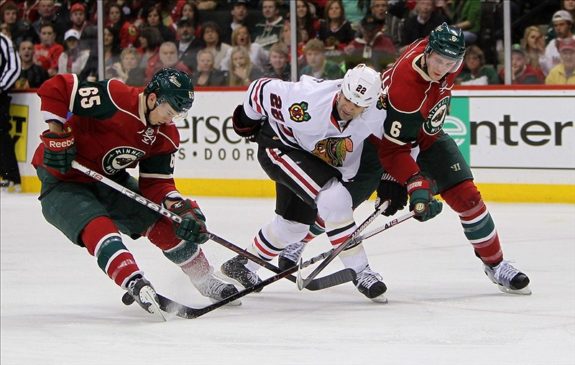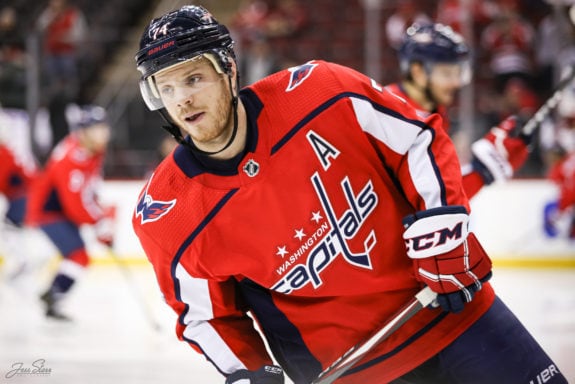The ninth installment in this series has arrived after previously looking at how the Minnesota Wild did in their first eight drafts. If you missed any of them or want a refresher, you can find those recaps below:
- 2000: Franchise’s Inaugural Draft
- 2001: Minnesota Gets Its Captain
- 2002: Late Round Woes
- 2003: Most Disappointing Draft Yet
- 2004: A Draft With No Standouts
- 2005: Starting the New Era Off with a Whimper
- 2006: More Missed Opportunities
- 2007: Prospect Cupboards Continue Being Empty
The Wild finished the 2007-08 NHL season with a 44-28-10 record, which was good enough to win the Northwest Division with 98 points. Unfortunately, they were once again unable to make it out of the first round, losing to the Colorado Avalanche in six games. That meant, once again, that the Wild looked to the NHL draft for help taking the team to the next level. By the time the 2008 NHL Draft concluded, Minnesota left the event with a total of four selections. Did any of these prospects properly develop and help the team or was it another bust of a draft class?
Early Rounds (First and Second)
Round 1, 23rd Overall – Tyler Cuma, D (Ottawa 67’s, OHL)
Entering the draft, the Wild owned the 24th-overall pick. However, on draft day, they wound up trading it and a 2009 third-round pick to the New Jersey Devils to move up one spot to select Ottawa 67’s defenseman Tyler Cuma. He was coming off of a season that saw him register 32 points in 59 games, showing how he was a solid two-way option in Ottawa. Nevertheless, Cuma needed more seasoning and stayed with the 67’s for two more seasons. He eventually signed a contract with the Wild, making his professional debut with the Houston Aeros in the American Hockey League (AHL) during the 2010-11 season. Unfortunately, Cuma’s campaign was cut short as he tore his ACL in February 2011. (‘Cuma tears left ACL in today’s Aeros’ loss at Xcel, expected to miss 6 months,’ Star Tribune, 02/13/2011)
The good news is that he managed to get healthy and play 73 games in the following AHL campaign, ending it without a goal but with six assists. The Wild even called him up for his first career NHL game; however, he only recorded a single penalty in 11:09 time on ice in a 2-1 shootout win over the Chicago Blackhawks. Cuma spent the following two seasons in the AHL, never sniffing the NHL game.

Cuma found himself leaving North America to go play in Austria ahead of the 2014-15 season. He’s stayed there to this day and currently plays for HC TWK Innsbruck, with who he had five points over 37 games in his most recent season. It’s too bad that Cuma’s ACL injury likely affected his NHL projectors as he was never the same player again. Still, he’s just the latest example in the Wild’s first-round selections failing early on in their careers. Considering who was drafted a few picks after Cuma, Minnesota would likely want to redo this selection.
Missed Opportunity: Washington Capitals Select John Carlson, D (Indiana Ice, USHL) – 27th Overall
The Washington Capitals selected John Carlson a couple of picks after Cuma at the No. 27 spot and haven’t looked back since then. After spending time in the Ontario Hockey League (OHL) and AHL, Carlson made his NHL debut in 2009-10, playing in 22 games. He didn’t look like the player we know today, finishing with just six points in his stint. Nevertheless, he never saw time in the AHL again and quickly became a mainstay on Washington’s blue line. He began to develop an offensive flair, as made evident by the first time he reached the 50-point mark in the 2014-15 campaign (55 points in 82 games). He continued becoming one of the top defensemen in the league as each season passed. Between 2017 and 2020, he tallied 213 points in 231 games (0.92 points per game), which is an extremely impressive total for a defenseman.

While Carlson has never won a Norris Trophy as the league’s top defenseman (he was nominated last season), that hasn’t stopped him from being one of the most respected players at his position. He has 522 points in 809 career games and was named to the NHL first and second All-Star teams in 2018-19 and 2019-20, respectively. He was also one of the main pieces that helped the Capitals win the Stanley Cup a few seasons ago. Considering how his career has played out, it’s hard not to imagine just where he could’ve taken the Wild had they drafted him over Cuma.
Round 2, 55th Overall – Marco Scandella, D (Val d’Or Foreurs, QMJHL)
As the Wild entered the second round of the draft, they decided to take another defenseman. This time, it was Marco Scandella of the Quebec Major Junior Hockey League’s (QMJHL) Val d’Or Foreurs. The Montreal-native didn’t waste time debuting at the professional level, as he was called up to the Aeros for two games following the 2008-09 QMJHL season. He found himself back in Val d’Or the following campaign, but turned professional fulltime in 2010-11. Scandella showed some offensive upside with the Aeros that season, tallying 19 points in 33 games. His efforts earned him 20 games with the Wild during that same campaign, but he recorded just two assists in that span.
Even though Scandella ended up playing in 63 games with Minnesota in 2011-12, he was stuck in the AHL for a majority of the 2012-13 lockout-shortened season. Fortunately for him, he was never sent down to the minors again after that season. He suited up in 284 games for the Wild between 2013 and 2017, scoring 23 goals and 51 assists during that time. That was the end of his run in Minnesota, though. On June 30, 2017, Scandella, Jason Pominville and a 2018 fourth-round pick were traded to the Buffalo Sabres in exchange for Tyler Ennis, Marcus Foligno and a 2018 third-round selection. Since then, he has also played for the Montreal Canadiens and St. Louis Blues.
Scandella was never a game-changing defenseman, but he was a consistent presence on the Wild’s blue line for a decent portion of the last decade. Besides, him being traded did bring in Foligno, who had his best season yet in 2020-21. Nevertheless, it’s always a bit underwhelming when a player of Scandella’s caliber is the best prospect that a team finds in any given draft.
Middle Rounds (3rd – 5th)
Round 4, 115th Overall – Sean Lorenz, D (US National Under-18 Team)
With the team’s third pick of the draft, the Wild selected another defenseman. A defensive defenseman, Sean Lorenz was coming off of a season with the United States National Under-18 Team that saw him record three points in 14 games. Rather than transition to the pros, he spent four seasons playing collegiate hockey at Notre Dame, which included when he was named captain for the 2011-12 season. Once that campaign concluded, he made his AHL debut with the Aeros, suiting up in two games. Unfortunately, that was the highest level that he played at. He scored nine points in 22 games with the ECHL’s Orlando Solar Bears during the following campaign, but that ended up being his final season playing professional hockey.
Round 5, 145th Overall – Eero Elo, LW (Lukko Jrs., Finland)
The Wild finally drafted a forward with their final pick of the 2008 NHL Entry Draft as they selected Eero Elo out of Finland. Highly touted for his size and shot release, Elo scored 12 goals and 15 assists in 42 games with Lukko’s under-20 team in the 2007-08 season. He even became a point-per-game player in the following campaign, scoring 46 points in 42 games with Lukko again. Unfortunately, his continued improvement never translated into him coming over to North America. Elo has remained in Europe for the entirety of his hockey career, having most recently played for Langenthal SC of the Swiss League in the 2020-21 season.
Overall Grade: D+
Even though the Wild only had four selections at the 2008 NHL Entry Draft, it’s not about the quantity: it’s about the quality. Unfortunately, Scandella was the only quality player they walked away with. Considering that this was the ninth draft in the franchise’s existence, it’s clear that Minnesota didn’t have the greatest scouts at the time. The first-round selections hadn’t really panned out since Brent Burns was drafted in 2003 and the team rarely found any diamonds in the rough over the later rounds. All in all, the 2008 Draft was just another disappointing effort to restock the organization’s prospect cupboards.